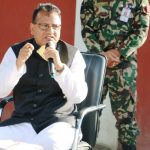Sangita Thapa
The everyday news and social media sensation of 18th SAARC Summit in Kathmandu left me with a deep thought. It is appreciable that Sheikh Hasina, the Bangladeshi Prime Minister was the only woman representative among the entire SAARC countries, while it is equally worrisome. The striking gender gap in SAARC member states, which went almost unnoticed, touched me deeply- why there is a general under-representation of women in politics, science, mathematics, engineering, or even in academia and research? The question looms larger and more vivid in Nepalese context, where there is low participation of women in every other sector as compared to men.
One of the research of a professor of Michigan University published in the New York Times magazine, reveals that the disparity between the male and female representation in science is cultural rather than genetic, which then proves that the cultural and social codes can affect an individual’s ability to perform. Meanwhile, a recent study at Yale also showed that a young male scientist is likely to be viewed more favourably than a woman with the same qualifications. Similar thoughts are echoed by a 2011 report of the American Association of University Women suggesting that the reason for women to leave engineering field was ‘uncomfortable work environment’ and the ‘inflexible’ and even ‘hostile’ environment to women. It will however take us long to realize that more participation of women in decisive positions could bring higher returns for society and families.
The Global Gender Gap Report (2013) puts Nepal in 121st position among 136 countries. There is inherent gender bias. Our society both at its outer physical and deep psychological level acclaims gender hierarchy and promotes stereotypes. Even among educated elites, a woman is considered less intelligent, less reliable and less capable altogether than the male counterpart with equal academic and professional caliber. If you are a woman, you are less likely to be accepted in traditionally challenging roles which are perceived as male-oriented areas, and you will likely be judged against values and ethical mores and your capacity will be underestimated oftentimes.
Personally as an aspiring researcher, I had a bitter experience when a local official from Bardiya National Park vehemently rebuked me for contacting him naming my research ‘wahiyat’ (nonsense) and ‘hamro samaya barbad garne’ (a wastage of our time) before hanging up the phone shouting, ‘Malai feri phone nagarnus ta’ (Don’t bother me again). He would have never spoken to me like that if I were a man. Although women are made to believe that there’s nothing hindering them from what they dream today, it seems the cultural, social and psychological constraints have always made their success stagnant, inaccessible beyond the glass ceiling.
More importantly, the success of woman is less appreciated and girls and young women are less encouraged to follow her dreams. A successful and independent single woman would be considered eccentric and deviant capable of (morally or psychologically) corrupting other women rather than a role model ushering positive change. The only salvation of a woman in our society is marriage and child-bearing. Undoubtedly, there are married women with children who are doing excellent but her marriage and child bearing are still the only priority for her family and husband.
A recent study by Elsevier in Asia shows that if girls and women are given greater access to education (traditionally male-oriented streams) they will eventually gain parity with men. Similarly, yet another study by university women in US reveals that the subtle and unconscious acts of bias often manifest in various ways making it less friendly for women to continue working or studying in such environment. Reluctance to issue citizenship through the name of mother in Nepal can also be associated with such bias inherent in social and cultural codes.
There is long way for us to achieve the millennium development goal of gender equality and women empowerment unless more women come in the policy and decision-making level. To achieve this end, more and more women need to be encouraged to lead all the sectors and dismantle the age-old androgynous system in Nepal.
Although with the strategy of 33 percent of women’s participation and different relevant amendments in the policies, we have paved a better way but as evident, it is insufficient for achieving the gender equality. The 33 percent women’s participation is more often than not based on the headcount rather than the true participation of women. Women should hence be encouraged to take decisive roles in parliaments, ministries, science and medicines, as well as in arts and technologies. Then maybe someday in future, we would witness several Nepali daughters representing Nepal in diplomacy, science, innovations, business and many such other realms, making our bosom swell with pride.
Ms. Thapa is a Development Study graduate and is involved in research with the Post-trafficking Livelihood Project in Nepal.






